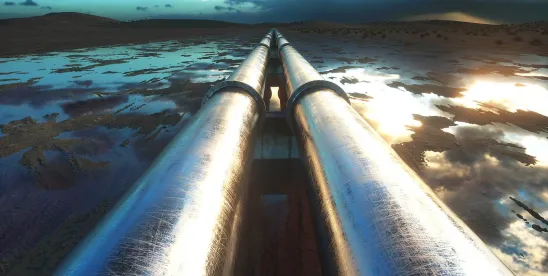On 17 January 2025, the D.C. Circuit Court of Appeals vacated a 2020 Pipeline and Hazardous Materials Safety Administration (PHMSA) rule—the “Hazardous Materials: Liquefied Natural Gas by Rail Rule” (the LNG-by-Rail Rule)—that allowed for the transportation of liquefied natural gas (LNG) on rail cars.1 The LNG-by-Rail Rule was challenged by a collection of environmental organizations, state governments, and tribal governments for failing to adequately consider the environmental impact of allowing LNG transport by rail. The decision to limit the domestic transportation of LNG conflicts with President Trump’s “American Energy Dominance” agenda and the stated intentions of the nominee for secretary of energy to expand US LNG infrastructure.2 In light of the D.C. Circuit vacating a PHMSA natural gas pipeline safety rule in August 2024 and the published-but-paused 17 January 2025 PHMSA final rule on pipeline methane emission detection requirements, this decision adds yet another element of regulatory uncertainty for domestic natural gas transportation as the second Trump administration prepares to implement its energy agenda.3
History of the LNG-by-Rail Rule
The LNG-by-Rail Rule was first promulgated by PHMSA during the Trump administration in October 2019 and permitted LNG to be transported subject to specific rail car tank requirements and operational controls.4 PHMSA determined that the LNG-by-Rail Rule would not trigger the preparation of an environmental impact statement (EIS) pursuant to the National Environmental Policy Act (NEPA).5 The final rule was published in July 2020 but was promptly suspended in 2021 by President Biden in a series of executive actions that reconsidered various Trump administration rules and actions that were deemed inconsistent with the Biden administration’s climate policies.6 PHMSA implemented the suspension before LNG transport by rail could occur, and directed that the suspension would last until 30 June 2025 or until PHMSA completed rulemaking amending the LNG-by-Rail Rule, whichever occurred first.7
Despite the suspension of the LNG-by-Rail Rule, the Biden administration continued to defend the LNG-by-Rail Rule against challenges from environmental groups, state governments, and tribal governments.8 During oral argument, the federal government claimed that it had no intention of modifying the LNG-by-Rail Rule—meaning that the suspension would lift in 2025 and the LNG-by-Rail Rule would retake effect. Petitioners challenged, among other issues, PHMSA’s decision to forgo the preparation of an EIS as arbitrary and capricious. The D.C. Circuit agreed, vacating the LNG-by-Rail Rule and remanding to PHMSA for further proceedings.9
Summary of the LNG-by-Rail Rule
In October 2019, PHMSA issued the Notice of Proposed Rulemaking in consultation with the Federal Railroad Administration after the Association of American Railroads (AAR) petitioned for a review of existing regulation concerning the transportation of LNG by rail.10 In its petition, the AAR cited the commercial interest in shipping LNG by rail, specifically from Pennsylvania to New England and between the US-Mexico border.11 The AAR noted that shipment by rail was “undeniably safer” that over-the-road transportation of LNG and compared LNG to the other, similar cryogenic liquids that PHMSA permits to be transported by rail.12 The petition specifically suggested that the DOT-113C120W (DOT-113) rail car be used for the shipment of LNG.13
Nine months later, PHMSA published the final rule authorizing the transportation of LNG by rail in DOT-113 tank cars.14 DOT-113 cars are designed to carry cryogenic liquids and have “numerous safety features that reduce the risk of an explosion or the release of cargo.”15 DOT-113 rail cars have typically been used to transport refrigerated ethylene and argon, and PHMSA required a number of safety and operational updates for DOT-113 cars used for transporting LNG.16 First, The LNG-by-Rail Rule required several physical updates to tank cars transporting LNG, including increased tank thickness, improved steel quality, the installation of remote monitoring devices, and advanced braking technology.17 Second, the LNG-by-Rail Rule increased the maximum filling density of each tank to reduce the number of rail cars needed for LNG transport and required railroads to adopt routing safety requirements for analyzing LNG transportation routes.18 Notably, the LNG-by-Rail rule did not include speed limits or tank car-per-train limits for trains transporting LNG.
PHMSA published an Environmental Assessment (EA) that “touted the demonstrated safety record” of the DOT-113 tank car and determined that the LNG-by-Rail Rule did not have a “significant impact on the human environment” and would therefore not require an EIS under Section 102(2) of NEPA.19
Challenges to the LNG-by-Rail Rule
A group of environmental petitioners, a collection of 15 states, and the Puyallup Tribe all petitioned the D.C. Circuit Court of Appeals to review the LNG-by-Rail Rule.20 The D.C. Circuit consolidated the appeals and reviewed petitioners’ arguments against the LNG-by-Rail Rule. Although the petitioners challenged the LNG-by-Rail Rule on multiple grounds, the D.C. Circuit only ruled on the question of whether PHMSA’s decision to forgo an EIS was arbitrary and capricious.21
Petitioners argued that PHMSA “disregarded” the DOT-113 tank car’s history of failure and ignored significant risk by failing to include car limits or speed limits for rail cars transporting LNG.22
The D.C. Circuit Court Ruling
The D.C. Circuit sided with petitioners and vacated the LNG-by-Rail Rule. Judge Florence Pan authored the opinion, joined on the panel by Judges Patricia Millet and A. Raymond Randolph. Even though the LNG-by-Rail Rule was suspended and there was at least the theoretical possibility of pending rulemaking, the court concluded that the case was ripe for review. The court found that transporting LNG by rail poses a “low-probability but high-consequence risk” to the environment in the case of a derailment.23 The spread of a “suffocating vapor cloud” or an “explosion” of the flammable material were “real possibilities” that PHMSA failed to consider in its EA, according to the decision.24 The court held that PHMSA should have considered the history of DOT-113 car derailments—two derailments in the last four years—and concluded that the risk of another derailment was “neither remote nor speculative.”25 Given the small number of DOT-113 cars in use and the history of failure, the court held that PHMSA’s assessment of environmental risk was insufficient.
Additionally, The D.C. Circuit held that by failing to impose a speed limit on rail cars transporting LNG or limit the number of LNG tank cars per train, the LNG-by-Rail Rule increased the risk of environmental impact from derailment.26 Although PHMSA did impose additional safety controls and mandated upgrades to the DOT-113 car, the court was unsatisfied by the safeguards and noted that PHMSA failed to explain how specific procedures were “adequate to address the extreme dangers associated with a derailment.”27
The D.C. Circuit concluded that the risk of an accident while transporting LNG by rail under the LNG-by-Rail Rule was sufficiently significant to require an EIS and remanded the LNG-by-Rail Rule to PHMSA for further proceedings.28 The court noted that the LNG-by-Rail Rule “raise[d] substantial environmental questions” that may require further review once an EIS was prepared, but expressed no opinion on the “wisdom of any particular set of safety protocols” for transporting LNG by rail.29
Revisiting the LNG-by-Rail Rule: The Trump Administration
The D.C. Circuit’s ruling—which came down the Friday before President Trump’s inauguration—will add another layer of complexity to any effort to reinstate the LNG-by-Rail Rule. For now, this hurdle remains procedural. To reinstate the LNG-by-Rail Rule, PHMSA will have to prepare an EIS and take into account the environmental risks before approving the transportation of LNG by rail. And while the D.C. Circuit expressed “no opinion on the wisdom of any particular set of safety protocols,” it left the door wide open to later challenges, explaining that “future legal challenges to the substance of that decision would . . . be brought under some other statute, not NEPA.”30
The Trump administration has not made any comment on the D.C. Circuit ruling or the LNG-by-Rail Rule specifically. However, the new administration has taken several actions indicating a substantial departure from the Biden position on natural gas. President Trump’s day-one executive orders have directed federal agencies to begin reviewing any policies that affected domestic energy production. The “Unleashing American Energy” and the “Declaring a National Energy Emergency” executive orders identify the development, transportation, and export of natural gas as a top priority.31
As the second Trump administration begins to take form and implement its “American Energy Dominance” agenda, regulating the domestic and international transportation of natural gas will remain a prominent focus. Over the coming months, the incoming leadership at the Departments of Energy, Interior, and Transportation are likely to act on a series of pressing natural gas policy questions. PHMSA will likely review major pipeline-related policies like the “Pipeline Safety: Gas Pipeline Leak Detection and Repair” rule finalized in the last days of the Biden administration but paused subject to President Trump’s “Regulatory Freeze Pending Review” executive order.32 Agencies have been granted emergency authority to “facilitate” domestic energy transportation, specifically on the West Coast, in the Northeast, and in Alaska.33 The Firm will continue to monitor this rapidly developing area of policy and provide relevant updates on our page.
Footnotes
1 Sierra Club, et al., v. U.S. Dep’t of Transp., et al., 2025 WL 223869 (D.C. Cir. 2025).
2 Timothy Gardner, Trump’s Energy Department Pick Calls for More LNG and Nuclear Power, Reuters (Jan. 15, 2025), https://www.reuters.com/business/energy/trumps-energy-department-pick-call-more-lng-nuclear-power-2025-01-15/.
3 David Wochner, Tim Furdyna, Stuart Robbins, D.C. Circuit Vacates New PHMSA Rules Related to Natural Gas Pipelines, K&L Gates (Aug. 28, 2024), https://www.klgates.com/DC-Circuit-Vacates-New-PHMSA-Rules-Related-to-Natural-Gas-Pipelines-8-28-2024; Pipeline Safety: Gas Pipeline Leak Detection and Repair, Pipeline and Hazardous Materials Safety Administration, Docket No. PHMSA-2021-0039 (Jan. 17, 2025).
4 Unleashing American Energy, The White House (Jan. 20, 2025), https://www.whitehouse.gov/presidential-actions/2025/01/unleashing-american-energy/.
5 Hazardous Materials: Liquefied Natural Gas by Rail, 85 Fed. Reg. 44994 (Jul. 24, 2020).
6 Exec. Order No. 13,990, 86 Fed. Reg. 7,037 (Jan. 20, 2021); Sierra Club at 10.
7 Sierra Club at 11.
8Id., at 10.
9 Id., at 24.
10 85 Fed. Reg. at 44996.
11 Petition for Rulemaking to Allow Methane, Refrigerated Liquid to be Transported in Rail Tank Cars, Association of American Railroads, PHMSA-2017-0020-0002 (Jan. 17, 2017) at 2.
12 Id., at 2-3.
13 Id., at 4.
14 85 Fed. Reg. at 44994.
15 Sierra Club at 6.
16 Id., at 20-21.
17 Id., at 9.
18 Id., at 9.
19 85 Fed. Reg. at 45027.
20 Sierra Club at 10 (Environmental petitioners included the Sierra Club, Center for Biological Diversity, Clean Air Council, Delaware Riverkeeper Network, Environmental Confederation of Southwest Florida, and Mountain Watershed Association; State petitioners included Maryland, New York, California, Delaware, the District of Columbia, Illinois, Massachusetts, Michigan, Minnesota, New Jersey, Oregon, Pennsylvania, Rhode Island, Vermont, and Washington).
21 Id., at 17 (Petitioners also brought claims under NEPA’s public participation requirement, the Hazardous Materials Transportation Act safety standards, the Administrative Procedure Act, and PHMSA’s failure to consider greenhouse gas emissions and environmental justice communities).
22 Id., at 17.
23 Id., at 19.
24 Id., at 19.
25 Id., at 20.
26 Id., at 22.
27 Id., at 23.
28 Id., at 24.
29 Id., at 23-24.
30 Id. at 23-24 n. 6.
31 Unleashing American Energy, The White House (Jan. 20, 2025), https://www.whitehouse.gov/presidential-actions/2025/01/unleashing-american-energy/; Declaring a National Energy Emergency, The White House (Jan. 20, 2025), https://www.whitehouse.gov/presidential-actions/2025/01/declaring-a-national-energy-emergency/.
32 Regulatory Freeze Pending Review, The White House (Jan. 20, 2025), https://www.whitehouse.gov/presidential-actions/2025/01/regulatory-freeze-pending-review/.
33 Declaring a National Energy Emergency, The White House (Jan. 20, 2025), https://www.whitehouse.gov/presidential-actions/2025/01/declaring-a-national-energy-emergency/.







 />i
/>i

